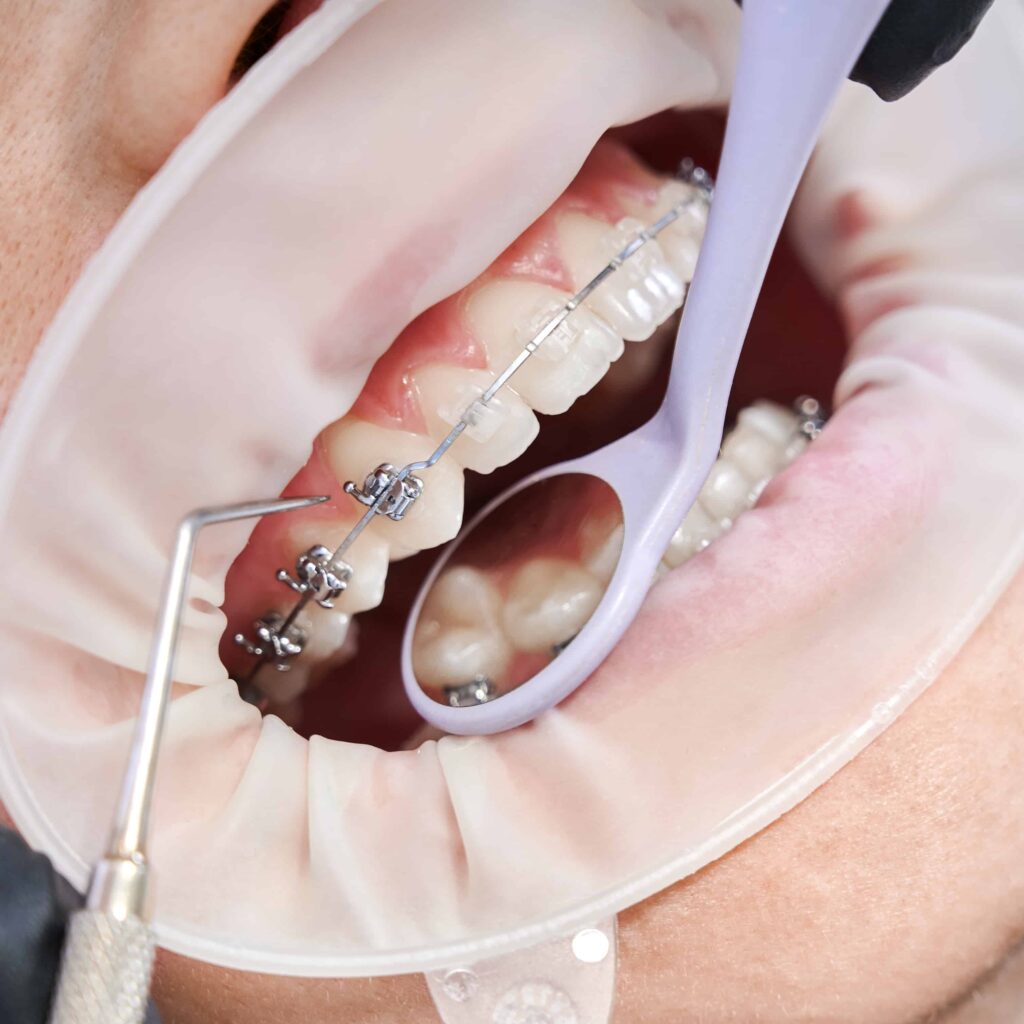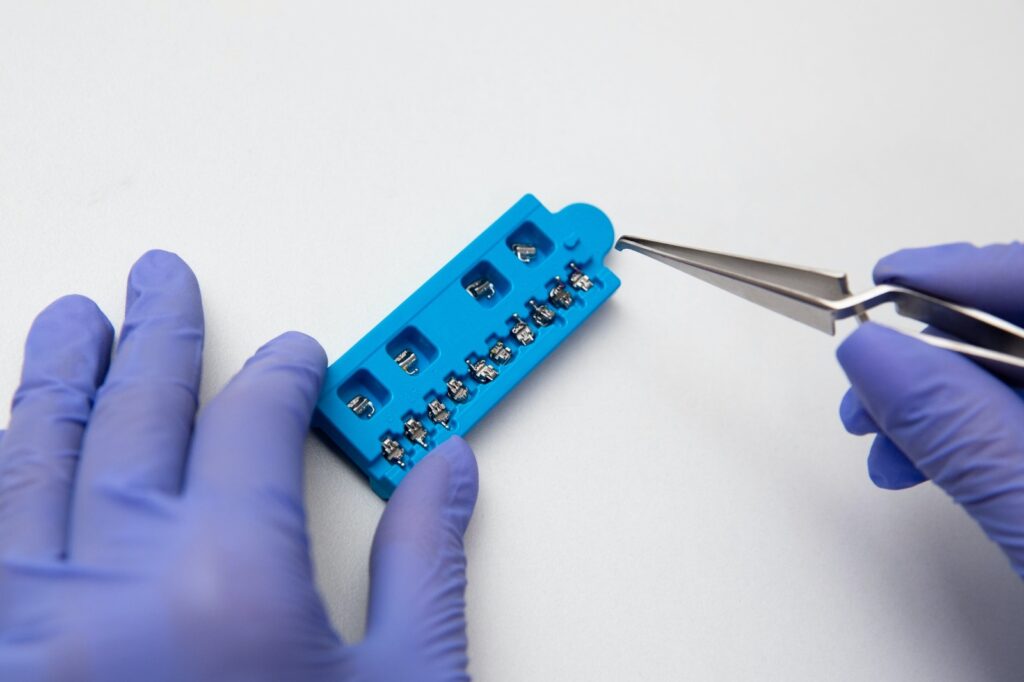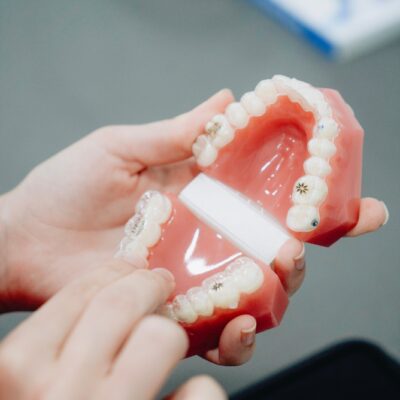Orthodontics
What Is Orthodontics?
Every single field of dentistry has its own purpose. You’ve probably heard about orthodontics hundreds of times before. But do you really know what orthodontics does or what an orthodontist can treat? If you are not completely sure, we’re here to provide you a complete guide with everything you need to know. First of all, orthodontics is a branch in dentistry also known as orthodontia, and the dentist who specializes is called an orthodontist. This field is concerned with the diagnosis and treatment of malpositioned teeth and jaws. It has a very important role in the prevention of different facial and oral malocclusions.
Having an imbalanced bite, misaligned teeth, crooked teeth or a visual malocclusion can have a strong effect on a person’s life, both physically and emotionally. It can really become a problem for young kids and teenagers. But orthodontics is the real solution for all these cases. And also it’s very important to know that orthodontic treatment is not only done for aesthetic purposes. In fact, it solves a number of other dental problems that can appear as a result to the malocclusion.

Types of Orthodontic Treatment
There is a wide number of appliances used to treat orthodontic cases. They can be divided into two large groups: fixed and mobile. The fixed ones stay inside the mouth of the patient during the course of the treatment, while the mobile ones are removable. Both groups include appliances that use active forces to get the desired result, functional ones or passive.
Various treatments in cosmetic dentistry
What Is A Malocclusion?
The term malocclusion is very commonly used. “Occlusion” defines the contact between the upper and lower teeth. Every single misalignment that falls out of the normal pattern is called a malocclusion. They are divided into three categories, where the first one is presented with a normal bite, but single or multiple teeth have misalignments such as rotations, crowded teeth, spaces and more. The second class is called an overbite, while the third one is presented with an underbite.


Indications
The range of conditions that are treated with orthodontic treatment is quite wide. These days, ideal smiles are very rare. It seems that every child needs a little help from an orthodontist to get that perfect shiny smile. As a part of the indications that orthodontists treat, you’ll find underbites, misplaced midline, crooked teeth, overbite, crossbite, crowding and more.
Overbite
Overbite is a very common condition, that should be treated by an orthodontics. When we say overbite, we mean that there is a change in the vertical dimension between the upper and lower central incisors. In other words, the maxillary incisors overlap the lower central incisors much more than usual. In most cases this condition is hereditary, but that is not the only factor that contributes to the appearance. In a number of cases, bad habits that occur at a young age can also lead to an overbite. Some of them include thumb-sucking, sucking on a certain object, nail-biting, long-term use of pacifiers and more.
Treating an overbite is not only meaningful for improving the aesthetics of the patient. Not having a proper occlusion often leads to a number of other dental problems. First of all, it can easily lead to gum disease. The lower incisors will get in touch with the gums located on the back surfaces of the upper frontal teeth. They will really irritate the gums, and soon cause recession. This is a very serious condition that might lead to the loss of teeth if not treated properly. The same thing can happen with the maxillary incisors, which can irritate the gums in the frontal part of the lower teeth. As a part of the physical appearance, patients have a characteristic look with a very prominent upper jaw. The chin appears as if it was located much more in the back than it was supposed to be. They are complaining to a number of difficulties, including jaw and joint pain, tooth wear, sleep apnea, tooth damage, breathing, chewing and more.

When it comes to the treatment, the dentist will first review the case and suggest the possible ways to treat an overbite. If it happens at an early age, and there is a certain bad habit present, the first thing to do is get rid of the habit. In most cases the sooner the treatment starts, the better. Orthodontic appliances are very often needed. They can be fixed or mobile, and it all depends on the individual case. If the overbite is caused by a skeletal defect, with a malformed jaw, in those cases surgery appears as an option.
Underbite
An underbite is another misalignment that is actually the complete opposite of an overbite. In these cases, the lower frontal teeth are overlapping the maxillary frontal teeth. The causes are numerous, but the most common one is of course genetics. It can be an incomplete development of the upper jaw, overly developed lower jaw or a combination of both factors. Both the mandible and lower frontal teeth are protruded in front of the upper ones.
The underbite can appear in several different forms. The first one is a mild presentation, that usually doesn’t bother the patient much regarding the aesthetics, but can still cause dental problems. If there is a more severe case, then you can easily recognize it by only looking at the patient. This is when they usually ask for help, mostly because the underbite affects their appearance.
An underbite is one of the most complicated orthodontic conditions to treat. As mentioned before, it is very impactful and you can notice it at first sight. Patients are really bothered by this, so they decide to visit a doctor. What you’ll see is a protruded lower jaw that overlaps the upper one. The same thing happens with the mandibular frontal teeth. The chin is also very much protruded. Just like with all the other malocclusions, patients with underbite can develop a number of other problems. Gum disease and caries are very common in these cases. Some of these people have a really hard time in providing proper oral hygiene. Also because of the reversed occlusion, there is a chance of recession and tooth loss. Other conditions include jaw and joint pain, difficulties in eating, chewing, breathing, enamel loss and more. When it comes to the treatment, if the patient is treated at an early, young age, then they will get a much faster and more permanent result. This is the time when dentists can actually influence the growth of the jaw and control it in time. With older patients, it will be a longer and more complicated process.


The underbite is usually treated with appliances and braces. There are also cases where surgery is recommended. Some of the appliances that provide great results are the upper jaw expander, fixed braces and the “reverse-pull” face mask.
Crossbite
A crossbite happens when a tooth or a group of teeth don’t meet correctly. In other words, the lower teeth overlap the upper ones. When there is a normal bite, the maxillary teeth always overlap the mandibular teeth. Even if there is one tooth out of this regular pattern, there is a crossbite. This malocclusion can happen as a result of a number of factors. It can appear in the frontal segments of the jaws or in the posterior. It can also happen on only one side, or on both. There are different cases with a different degree of severity. It can be hereditary or influenced by a skeletal factor.
The most common dental problems associated with crossbite are gum disease, caries, difficulty with oral hygiene, jaw and joint pain, headaches, difficulties in chewing and more. It is always treated by an orthodontist with either braces or appliances depending on the age and case. Some patients need to wear quad helix appliances, Delaire masks, palatal expanders, fixed braces and more.
Open Bite
Another common malocclusion that has to be treated in time. Open bite is a condition where the upper and lower front teeth are missing contact even the mouth is closed. In an ideal case, the upper front teeth overlap the mandibular ones for a few millimeters. With these patients, there is no contact between the frontal teeth. The number of reasons behind this condition is bad habits, genetics, skeletal problems and more. Bad habits at an early age, such as thumb sucking, sucking on blankets, other objects, tongue thrusting are factors that can lead to an open bite. These habits should be removed as soon as possible.
An open bite can vary from a very mild one, presented with a very small gap, to a severe one. Either way, it should be treated by an orthodontist. If not, it will cause a number of other problems including difficulties in breathing, eating, gum disease and more.
The treatment always depends on the individual case. For open bite cases, age and why it appeared in the first place is also important. If the doctor notices a bad habit, he will advise the parents to try and remove it as soon as possible. In addition, the patient will need to wear appliances. The skeletal forms of an open bite are very hard to treat. They usually require surgery, especially at an older age.
Teeth Spacing
For most people teeth crowding is the usual problem when it comes to teeth and jaws. But there are those people that are affected by teeth spacing. We’re talking about spaces between frontal or posterior teeth that are not supposed to be there. The reasons are numerous. First of all, it can appear as a part of the development of the jaws. The patient can inherit large jaws with small teeth, normal jaws with small teeth and large jaws with normal teeth. Another factor is the extraction of teeth. Some patients are simply born without a certain tooth. The treatment is only recommended when the spaced teeth are an aesthetic problem for the patient.
Teeth Crowding
Just like the previous condition, teeth crowding happens because of hereditary factors. The patient can inherit small jaws and large teeth, small jaws and normal teeth and normal jaws and large teeth. Unfortunately, crowding happens very often. Among other reasons, you’ll find extra teeth and the premature loss of primary teeth. The treatment involves appliances, depending on the severity. If we are talking about only one tooth, there is no need to undergo any treatment, unless the patient wants to. If it’s a more severe case, it can lead to gum disease, caries and more. In those cases, dentists use either fixed or removable braces depending on the age. Extraction is another way to go.
Misaligned Dental Midlines
For some people, this is a barely noticeable problem, while others can’t live with it. It is usually barely noticeable, but there are cases where you can clearly see the misaligned midlines. A midline is actually a line that passes between the two central upper and lower incisors. If the contacts between the maxillary and mandibular incisors don’t form a straight line, there is a misalignment. If it’s only a slight misalignment, that doesn’t cause any problems in the oral cavity, then it shouldn’t be treated. But if it’s an aesthetic problem and also causes other difficulties it should be treated.
Orthodontic Treatment
All of the orthodontic malocclusions and misalignments can be easily discovered with a visit to the orthodontist. He will do a thorough exam, note any symptoms intraoral and extraoral, and also do x-rays. Once all of that is done, the orthodontist will be able to give you a detailed explanation of your problem, and all the possible solutions. The type of treatment depends on the age, type of malocclusion, financial status, and the patient’s wishes.

This is actually the most commonly used treatment method in orthodontics. The reason behind that is the fact that braces are indicated for a wide range of conditions. They are available for different ages and are getting more affordable each year. These braces are fixed, which means they are placed on the teeth and stay there for a longer time. The time of the treatment can vary, but it is usually more than a year. Fixed appliances can be made of metal or porcelain. The metal ones are less appealing when it comes to aesthetics, but are very efficient. Every appliance includes brackets that are bonded to the surfaces of the teeth. Sometimes they are placed on one jaw, sometimes on both, depending on the malocclusion. The brackets are connected with a special archwire and ligatures. There are two other types of fixed appliances, which are usually used at an early age. The first one is used in the treatment of bad habits such as thumb sucking, tongue thrusting, nail-biting, and more. The second one is made of fixed space maintainers, used during mixed dentition. When a primary tooth is lost prematurely, that space has to be saved, to prevent the movement of surrounding teeth.
There are several different techniques for placing the fixed appliances. There is a vestibular technique, where the brackets are placed on the frontal surfaces of teeth, and a lingual one when they are placed on the inner surfaces. As mentioned, metal brackets are much more noticeable but are very efficient. The ceramic ones are also a great choice, especially for patients that like a smile with a better aesthetics.

As mentioned before, their indication range is quite impressive. Fixed appliances are used in all the different types of malocclusions, including overbite, underbite, open bite, cross bite, crowded teeth, spacing and more. Thanks to fixed braces rotated teeth can be corrected in the proper position. The metal type
The best thing about fixed appliances is that the patient feels very comfortable while wearing them. They can eat, talk, breathe, sing, chew without a single problem. They might feel slight pain and discomfort during the first few days of adaptation. From there on, the braces will only correct all the problems in the oral cavity. Orthodontists usually schedule check-ups once a month. During that time, the patient has to really take care of the oral hygiene and use special toothbrushes meant for fixed braces.
Removable Appliances
Another commonly used group of orthodontic appliances. The difference is that they don’t have to stay put in the mouth during the whole treatment. The patient can feel free to remove them while eating, or any other activities. In spite of the general belief, that the mobile braces are only meant for kids, everyone can be treated with them. It all depends on the type of misalignment. Some of them use active forces, such as the functional appliances, while others are passive, such as the retainers and space maintainers. Compared to the fixed braces, the range of indications is much smaller for the mobile ones. The patient has to completely follow the orthodontist’s instructions in order to get the desired results.
Retainers
Once the treatment is done, each patient has to wear retainers, to really preserve the final result. Teeth are prone to moving, so orthodontists found a way to prevent that. Retainers are mobile appliances, usually made of a transparent material. There are also fixed retainers made of one archwire that is placed on the lingual surfaces of the teeth. This wire is fixated on a composite material and stays there for a certain amount of time. Patients are advised to wear the removable retainers during the night.
Invisalign
This is a very popular and fairly new type of orthodontic treatment. It became so trending among patients, mostly because of its great aesthetic side. Most of the time, people can’t even notice that someone is wearing an Invisalign appliance. We’re talking about clear appliances that are barely noticeable. It consists of several different trays with individually made retainers. The patient starts the treatment by wearing the first retainer in the group for a certain amount of time. From there on, he switches to the other retainers one by one. With each new retainer, the patient will notice more changes in their smile. The range of indications is not as wide as the previous two types. The only downside to the Invisalign method is that it’s still very expensive.
Functional Appliances
Functional appliances are very useful during the period of growth. This group includes both fixed and mobile ones and they all affect the oral and perioral musculature. The muscles surrounding the mouth have a great importance of the appearance and the treatment of malocclusions. These appliances use the forces of the muscles to correct a certain misalignment. They can influence the growth of the jaws.
The Importance of Orthodontics
Getting an orthodontic treatment is not only about looking great. It is also about treating all the dental problems that might occur as a result of a malocclusion. Patients are often having problems with breathing, chewing, swallowing because of a certain orthodontic problem. Most of them, first visit the doctor because they want a perfect smile. Not having great teeth, and visual physical malocclusions can really affect the confidence of people. To avoid that, parents need to be very aware and take their kids to regular dental appointments. If the malocclusion is noticed in the early stages, orthodontists can easily influence and treat it. Other common problems include the appearance of gum disease, gingivitis, dental decay, jaw pain, joint pain, headaches, digestion problems, and much more. All of this can be avoided with the proper orthodontic treatment.
